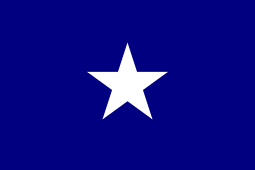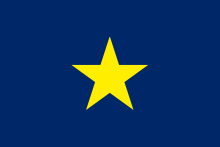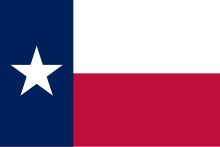Texas Blue Flag Wallpaper Texas Blue Flag White Star Wallpaper
 | |
| Use | Banner |
|---|---|
| Design | A dark blue banner charged with a white star |
The historic symbolism of the "Bonnie Blue Flag" is independence and self-sufficiency. The Bonnie Blue flag was a banner associated at various times with the Republic of Texas, the short lived Republic of West Florida, and the Confederate States of America at the start of the American Civil War in 1861. It consists of a single, five-pointed white star on a blue field. Its first known use was in 1810.
History [edit]

Flag of the Republic of West Florida (1810)

The Burnet flag Co-Official 1836 - 1839

De Zavala Flag Co-Official 1836 - 1839

Flag of Texas 1839 - Present

The first recorded use of this flag (typically with a white star) was in 1810 when it was used to represent the Republic of West Florida, a republic of English-speaking inhabitants in parts of Louisiana east of the Mississippi River who rebelled against the reign of Spanish government and overthrew Spain's district governor, Carlos de Hault de Lassus, at Baton Rouge. The republic's independence lasted barely three months, dissolved after the annexation of Louisiana's portion of the disputed land to the United States territory acquired in the Louisiana Purchase.
Later referred to as the Burnet flag, it was adopted by the Congress of the Republic of Texas on December 10, 1836. This version consisted of an azure background with a large golden star, inspired by the 1810 flag of the Republic of West Florida.[1] Variants of the Burnet flag with a white star, virtually identical to the Bonnie Blue flag, were also common. Other variants featured the star, of either color, upside down, and/or ringed with the word Texas, with each letter filling one of the gaps of the star (the De Zavala flag). These flags, combined with the flag of the Fredonian Rebellion, are ancestral to the modern flag of Texas.
When the state of Mississippi seceded from the Union in January 1861, a flag bearing a single white star on a blue field was flown from the capitol dome.[2] Harry Macarthy helped popularize this flag as a symbol of independence, writing the popular song "The Bonnie Blue Flag" early in 1861. Some seceding Southern states incorporated the motif of a white star on a blue field into new state flags.[3]
Although the name "Bonnie Blue" dates only from 1861, there is no doubt that the flag is identical with the banner of the Republic of West Florida.[4] [5] In 2006 the state of Louisiana formally linked the name "Bonnie Blue" to the West Florida banner, passing a law designating the Bonnie Blue flag as "the official flag of the Republic of West Florida Historic Region".[6]
The Bonnie Blue flag was used as an unofficial flag during the early months of 1861. It was flying above the Confederate batteries that first opened fire on Fort Sumter, beginning the Civil War. In addition, many military units had their own regimental flags they would carry into battle.
In 2007, one of six known Bonnie Blue flags from the Civil War era was sold at auction for US$47,800. The flag had been carried by the Confederate 3rd Texas Cavalry, and later exhibited as part of the 1936 Texas Centennial Exposition.[7]
The historic symbolism of the "Bonnie Blue Flag" is independence and self-sufficiency. The flag is often flown while at sea by the solo sailor. Its blue field represents the Arctic, North Atlantic, South Atlantic, North Pacific, South Pacific, Indian, and Southern oceans with a single white star, representing the single-handed sailor. It allows merchant ships, harbor masters, and the coast guard to know the sailor is alone and without the assistance of a crew.
In popular culture [edit]
In the 1936 novel by Margaret Mitchell and the 1939 film Gone with the Wind, Rhett Butler nicknames his newborn daughter "Bonnie Blue" after Melanie Wilkes remarks that her eyes will be "as blue as the bonnie blue flag."[8] [9]
Both flag and song appear in the film Gods and Generals (2003).
See also [edit]
- Flags of the Confederate States of America
- "The Bonnie Blue Flag" – 1861 song by Irish Ulster-Scots entertainer Harry McCarthy.
- Flag of Somalia – A similar national flag
- Flag of Bosnia & Herzegovina
- Flag of Kosovo
References [edit]
- ^ Allman, T.D. (2013). Finding Florida The True History of the Sunshine State (First ed.). New York: Atlantic Monthly Press. p. 63. ISBN978-0-8021-2076-2.
- ^ Winik, Jau (February 11, 2001). "A New Flag for a New Mississippi". The New York Times. p. 17.
- ^ Coski, John (2005). The Confederate Battle Flag: America's Most Embattled Emblem. Harvard University Press. pp. 2–3.
- ^ Davis, William C. (2011). The Rogue Republic: How Would-Be Patriots Waged the Shortest Revolution in American History. Houghton Mifflin Harcourt. p. 295. ISBN9780547549156.
- ^ Frois, Jeanne (1995). Flags of Louisiana. Gretna, Louisiana: Pelican Publishing Co. p. 45. ISBN9781455604364.
- ^ "2006 Louisiana Laws - RS 25:705 — Bonnie Blue flag adopted". Justia US Law . Retrieved 2 Aug 2012.
- ^ Heritage Auctions. "Rare Texas Confederate "Bonnie Blue" Flag of the 3rd Texas State Cavalry". Auction Web Press Release. ha.com. Retrieved 29 June 2012.
- ^ Mitchell, Margaret (30 September 2013). Gone with the Wind. ISBN9789633472378.
- ^ Levitski, O.; Dumer, O. (Sep 2006). "Bestsellers: Color Symbolism and Mythology in Margaret Mitchell's Novel Gone with the Wind". Americana: The Institute for the Study of American Popular Culture.
Source: https://en.wikipedia.org/wiki/Bonnie_Blue_flag
0 Response to "Texas Blue Flag Wallpaper Texas Blue Flag White Star Wallpaper"
Post a Comment